Abstract
Objective
To examine the use and perceived safety of stylets for neonatal intubation in a cohort of providers in the United States.
Study design
A cross-sectional survey was sent to members of the American Academy of Pediatrics Section on Neonatal-Perinatal Medicine.
Result
A total of 640 responses were received. 57% reported using a stylet ‘every time’ or ‘almost every time’ they intubated. The preferred stylet bend was a smooth bend of <30 degrees. 71% of respondents believed that stylets were safe. Reported complications from stylet use included tube dislodgement during stylet removal (32%), airway injury with bleeding (9%), and tracheal perforation (2%).
Conclusion
Stylet use was common. There was fair consistency on preference for stylet bend and position. Stylet use was believed to be safe, but complications were observed by many respondents. Additional studies are needed to examine the risks and benefits of stylet use during neonatal intubation.
This is a preview of subscription content, access via your institution
Access options
Subscribe to this journal
Receive 12 print issues and online access
$259.00 per year
only $21.58 per issue
Buy this article
- Purchase on Springer Link
- Instant access to full article PDF
Prices may be subject to local taxes which are calculated during checkout



Similar content being viewed by others
References
Sawyer T, French H, Ades A, Johnston L. Neonatal-perinatal medicine fellow procedural experience and competency determination: results of a national survey. J Perinatol. 2016;36:570–4.
Foglia EE, Ades A, Napolitano N, Leffelman J, Nadkarni V, Nishisaki A. Factors associated with adverse events during tracheal intubation in the NICU. Neonatology. 2015;108:23–9.
Haubner LY, Barry JS, Johnston LC, Soghier L, Tatum PM, Kessler D, et al. Neonatal intubation performance: room for improvement in tertiary neonatal intensive care units. Resuscitation. 2013;84:1359–64.
Wallenstein MB, Birnie KL, Arain YH, Yang W, Yamada NK, Huffman LC, et al. Failed endotracheal intubation and adverse outcomes among extremely low birth weight infants. J Perinatol. 2016;36:112–5.
Sauer CW, Kong JY, Vaucher YE, Finer N, Proudfoot JA, Boutin MA, et al. Intubation attempts increase the risk for severe intraventricular hemorrhage in preterm infants-a retrospective cohort study. J Pediatr. 2016;177:108–13.
Hatch LD, Grubb PH, Lea AS, Walsh WF, Markham MH, Whitney GM, et al. Endotracheal intubation in neonates: a prospective study of adverse safety events in 162 infants. J Pediatr. 2016;168:62–6.e6.
Venkatesh V, Ponnusamy V, Anandaraj J, Chaudhary R, Malviya M, Clarke P, et al. Endotracheal intubation in a neonatal population remains associated with a high risk of adverse events. Eur J Pediatr. 2011;170:223–7.
O’Donnell CP, Kamlin CO, Davis PG, Morley CJ. Endotracheal intubation attempts during neonatal resuscitation: success rates, duration, and adverse effects. Pediatrics. 2006;117:e16–21.
O’Shea JE, O’Gorman J, Gupta A, Sinhal S, Foster JP, O’Connell LA, et al. Orotracheal intubation in infants performed with a stylet versus without a stylet. Cochrane Database Syst Rev. 2017;6:Cd011791.
Hilton MT, Carlson JN, Chan S, Phrampus PE. Impact of stylet use in a simulated difficult airway model. Am J Emerg Med. 2013;31:578–80.
Kamlin CO, O’Connell LA, Morley CJ, Dawson JA, Donath SM, O’Donnell CP, et al. A randomized trial of stylets for intubating newborn infants. Pediatrics. 2013;131:e198–205.
Chiou HL, Diaz R, Orlino E Jr, Poulain FR. Acute airway obstruction by a sheared endotracheal intubation stylet sheath in a premature infant. J Perinatol. 2007;27:727–9.
Cook WP, Schultetus RR. Obstruction of an endotracheal tube by the plastic coating sheared from a stylet. Anesthesiology. 1985;62:803–4.
Fathi M, Farzanegan B, Mojtabaee M, Nikzamir A. A piece of broken metal from intubation stylet retained in tracheobronchial tree: a case report. Tanaffos. 2014;13:51–4.
Sharma PK, Khan RM, Kaul N. An unnoticed broken sheathed metallic stylet in an endotracheal tube: a case report. Sultan Qaboos Univ Med J. 2010;10:126–8.
Chalhoub V, Richa F, El-Rassi I, Dagher C, Yazbeck P. Pulmonary migration of a fragment of plastic coating sheared from a stylet. J Emerg Med. 2013;44:1097–100.
Koodiyedath B, Tyler W, Deshpande SA, Parikh D. Endobronchial obstruction from an intubation stylet sheath. Neonatology. 2008;94:304–5.
Boyd RL, Bradfield HA, Burton EM, Carter BS. Fluoroscopy-guided retrieval of a sheared endotracheal stylet sheath from the tracheobronchial tree in a premature infant. Pediatr Radio. 1999;29:575–7.
American Academy of Pediatrics Section on Neonatal Perinatal Medicine. 2018. https://www.aap.org/en-us/about-the-aap/Committees-Councils-Sections/Neonatal-Perinatal-Medicine/Pages/Neonatal-Perinatal-Medicine.aspx.
Leone TA, Rich W, Finer NN. Neonatal intubation: success of pediatric trainees. J Pediatr. 2005;146:638–41.
Levitan RM, Pisaturo JT, Kinkle WC, Butler K, Everett WW. Stylet bend angles and tracheal tube passage using a straight-to-cuff shape. Acad Emerg Med. 2006;13:1255–8.
Fan CM, Ko PC, Tsai KC, Chiang WC, Chang YC, Chen WJ, et al. Tracheal rupture complicating emergent endotracheal intubation. Am J Emerg Med. 2004;22:289–93.
Author information
Authors and Affiliations
Corresponding author
Ethics declarations
Conflict of interest
The authors declare that they have no conflict of interest.
Electronic supplementary material
Rights and permissions
About this article
Cite this article
Gray, M.M., Umoren, R.A., Harris, S. et al. Use and perceived safety of stylets for neonatal endotracheal intubation: a national survey. J Perinatol 38, 1331–1336 (2018). https://doi.org/10.1038/s41372-018-0186-8
Received:
Revised:
Accepted:
Published:
Issue Date:
DOI: https://doi.org/10.1038/s41372-018-0186-8
This article is cited by
-
Neonatologists’ preferences regarding guidelines for periviable deliveries: do we really know what we want?
Journal of Perinatology (2019)



